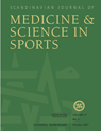Time course of muscular, neural and tendinous adaptations to 23-day unilateral lower-limb suspension in young men
Abstract
Muscles and tendons are highly adaptive to changes in chronic loading, though little is known about the adaptative time course. We tested the hypothesis that, in response to unilateral lower limb suspension (ULLS), the magnitude of tendon mechanical adaptations would match or exceed those of skeletal muscle. Seventeen men, (1.79±0.05 m, 76.6±10.3 kg, 22.3±3.8 years underwent ULLS for 23 days (n=9) or acted as controls (n=8). Knee extensors (KE) torque, voluntary activation (VA), cross-sectional area (CSA) (by magnetic resonance imaging), vastus lateralis fascicle length (Lf) and pennation angle (vartheta), patellar tendon stiffness and Young's modulus (by ultrasonography) were measured before, during and at the end of ULLS. After 14 and 23 days, (i) KE torque decreased by 14.8±5.5% and 21.0±7.1%, respectively (P<0.001); (ii) VA did not change; (iii) KE CSA decreased by 5.2±0.7% (P<0.001) and 10.0±2.0% (P<0.001); Lf decreased by 5.9% (NS) and 7.7% (P<0.05) and vartheta by 3.2% (P<0.05) and, (iv) tendon stiffness and modulus decreased by 9.8±8.2% (P<0.05) and 9.2±8.2% (P<0.05) at 14 days, and by 29.3±11.5% (P<0.005) and 30.1±11.9% (P<0.01) at 23 days, with no changes in the controls. Hence, ULLS induces rapid losses of KE muscle size, architecture and function, but not in neural drive. Significant deterioration in tendon mechanical properties also occurs within 2 weeks, exacerbating in the third week of ULLS. Rehabilitation to limit muscle and tendon deterioration should probably start within 2 weeks of unloading.




